THE IMPACT OF HANDBALL ON STUDENTS' COMPREHENSION OF READING IN TERMS OF ITS PHYSICAL ASPECT
DOI:
https://doi.org/10.47390/SPR1342V4I9Y2024N44Keywords:
physical activity, functional system, adaptation, functional parameters, adequate change, reaction speed.Abstract
In this article, the level of performance and dynamics of athletes with different levels of adaptation to specific muscle activity is determined. The results of the study show that as the level of education increases, the coefficient of variation, which reflects the level of preparation of student-athletes in the group, decreases, that is, the levels of preparation of athletes approach each other. another. In particular, the coefficients of change among the handball players of the first stage students ranged from V=12.96% to V=15.98%, while for the students of the second stage, this indicator was V=12, 29%, reaching values in the range of V=. 15.22%, but it can be observed that in stage III they decreased (i.e. improved) to the values of V = 11.58% and V = 14.37%.
References
1. Anderson, J. va Smit, R. (2021). Jismoniy tarbiyada texnologiyani integratsiyalashning muammolari va imkoniyatlari. Jismoniy tarbiya tadqiqotlari jurnali, 6(2), 25-36.
2. Karter, A., Wolf, D. va Griffin, T. (2022). Jismoniy tarbiya fanida o'rta maktab o'quvchilari o'rtasida fitnesni kuzatish texnologiyasidan foydalanish. Sport fanlari va murabbiyligi xalqaro jurnali, 18(4), 549-563.
3. Koen, L., Vaskes, M. va Robinson, P. (2021). Raqamli asrda tenglik: jismoniy tarbiya texnologiyalaridan foydalanishdagi nomutanosibliklar. Journal of Education Policy, 36(1), 44-56.
4. Xodj, K. va Rayt, K. (2021). Jismoniy tarbiya faniga texnologiya orqali talabalarni jalb qilish. Jismoniy tarbiya va sport pedagogikasi, 26(1), 1-16.
5. Xvang, G. va Chen, P. (2021). Onlayn ta'limning o'quvchilarning jismoniy tarbiyadagi faolligiga ta'siri. Inson xulq-atvoridagi kompyuterlar, 114, 106586.
6. Huang, Y. va Li, L. (2022). Jismoniy tarbiya o'qituvchilarining kasbiy rivojlanishi: sinfda texnologiyadan foydalanish. Journal of Educational Technology & Society, 25(1), 103-117.
7. Jonson, M. va Larkin, A. (2022). Jismoniy tarbiyada yordamchi texnologiyalar: inklyuzivlikka yaqinroq qarash. Moslashtirilgan jismoniy faoliyat jurnali, 39 (2), 203-216.
8. Kirk, D. (2021). COVID-19 davrida jismoniy tarbiya bo'yicha navigatsiya: olingan saboqlar. Yevropa jismoniy tarbiya sharhi, 27(3), 341-356.
9. Krause, L. va Klassen, J. (2021). Jismoniy tarbiya sohasidagi innovatsiyalar: VR va AR-dan o'quv natijalarini yaxshilash uchun foydalanish. Sport va mashqlar psixologiyasi jurnali, 43 (4), 290-302.
10. Lancaster, S. va McKenzie, M. (2021). Tafovutni bartaraf etish: Pandemiyadan keyin talabalarni jalb qilishda texnologiyaning roli. Jismoniy tarbiya, sport va salomatlik sohasidagi tadqiqotlar, 10(1), 50-64.
11. Richards, K. va Morrow, J. (2021). Video tahlili jismoniy tarbiya fanidan fikr-mulohazalar uchun vosita sifatida. Jismoniy tarbiya xalqaro jurnali, 58(2), 30-47.
12. Ochilova, M. (2021). ЭЛЕКТРОН ЛУҒАТ–ЛЕКСИКОГРАФИЯ РИВОЖИНИНГ ЯНГИ БОСҚИЧИ МАҲСУЛИ. ЦЕНТР НАУЧНЫХ ПУБЛИКАЦИЙ (buxdu. uz), 8(8).
13. Dilova, N. G. (2021). O ‘quvchining shaxsiy sifatlari pedagogik hamkorlikning dastlabki tamoyili. Science and Education, 2(10), 558-566.








